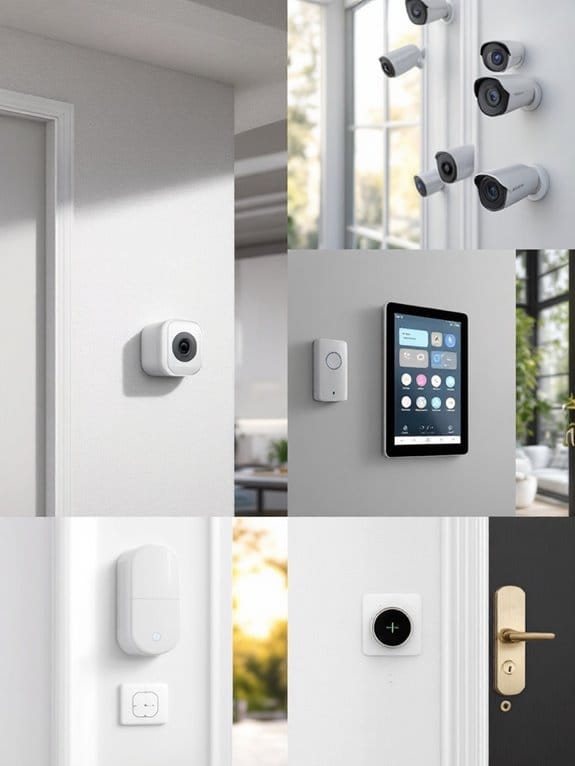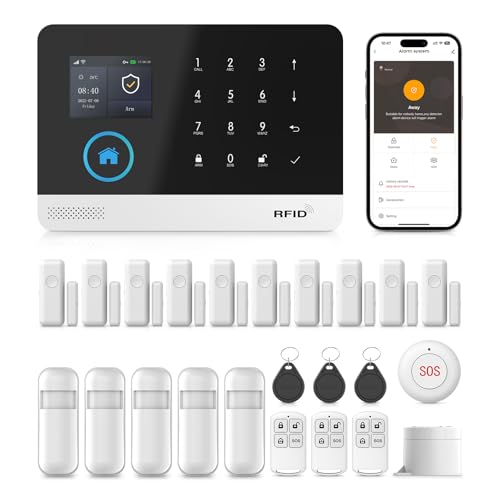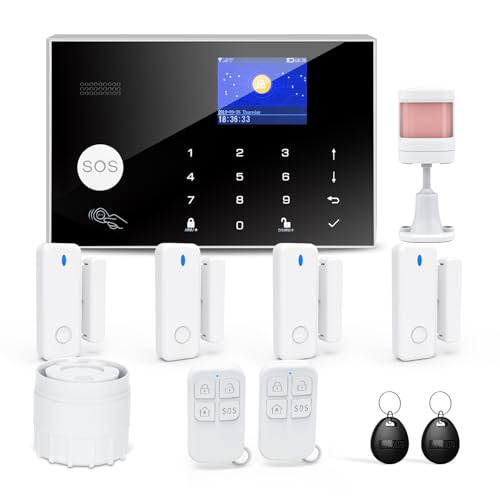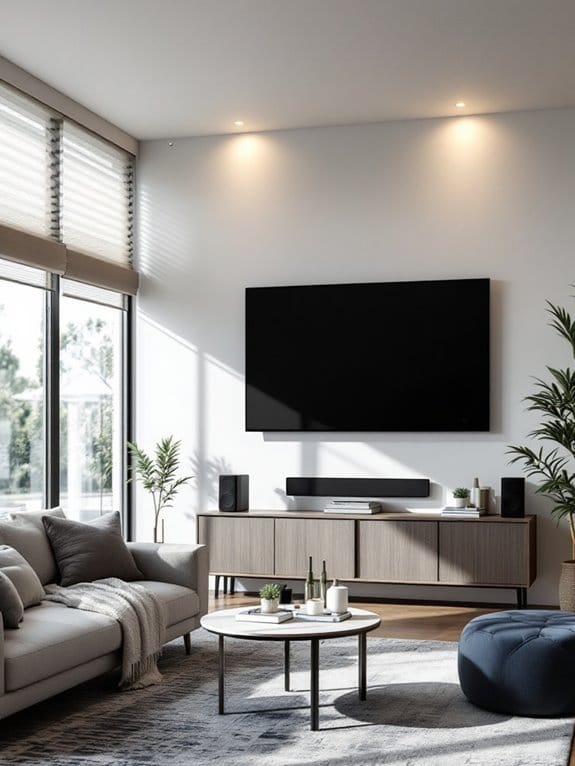As an Amazon Associate, we earn from qualifying purchases. Some links may be affiliate links at no extra cost to you. Although our opinions are based on curated research, we haven't used these products. Articles generated with AI.

5 Best Automated Home Security Systems
The top automated home security systems offer extensive protection through smart integration and mobile alerts. After testing multiple systems, we recommend the 24-piece Wireless Home Security Kit for large homes, Tuey's 8-piece system for apartments, and HTZSAFE's long-range system for properties with driveways. The Tuya Smart System and WiFi/4G Alarm System round out our top picks, each providing reliable protection with no monthly fees. Let's explore what makes these systems stand out from the competition.
Key Takeaways
- 24-Piece Wireless Home Security Kit offers comprehensive protection with 10 door sensors, 5 motion detectors, and Smart Life app integration.
- Tuya Smart Home Security System provides dual-network connectivity through GSM and Wi-Fi, eliminating single points of failure.
- Home Security Alarm System with WiFi/4G includes 21 pieces with quick DIY setup and Alexa compatibility.
- Long-range wireless systems can cover properties up to half a mile with reliable motion detection up to 50 feet.
- Smart home integration enables voice control through Alexa or Google Assistant with real-time mobile notifications.
Wireless Home Security Alarm System, 24-Piece Kit with APP Alert
PGST Wireless Home Alarm System, 24-Piece Kit with Phone APP Alert, Door Sensor, Siren, Remote,...
- Easily DIY Installation: Get ready to protect your home security right out of the box. Set up in minutes all by yourself. No wiring or drilling required.
- No Monthly Fees: PGST WiFi Alarm System is a one-time purchase at no extra fee and provides 24-hour comprehensive protection for your home security.
- Remote/Voice Control: Take full control of your home security system through the Smart Life app - arm, disarm and protect anytime, anywhere. Connect alarm siren with...
Last update on 2025-12-17 / Affiliate links / Images from Amazon Product Advertising API
The PGST Wireless Home Security Alarm System stands out as an ideal solution for DIY-minded homeowners who want extensive protection without monthly fees or complex installations. This 24-piece kit includes 10 door sensors, 5 motion detectors, and multiple control options to secure your home thoroughly.
We've found the system's integration with Smart Life app particularly useful, allowing you to receive real-time alerts and control your security setup remotely. You'll appreciate the powerful 120 dB siren that triggers when sensors detect intrusion, while the system's expandability lets you add up to 99 sensors for complete coverage. Though the 2.8-star rating suggests room for improvement, the easy setup and subscription-free monitoring make it worth considering for budget-conscious homeowners.
Best For: Budget-conscious homeowners seeking a DIY security system with extensive coverage options and no monthly fees who are comfortable with basic smart home technology.
Pros:
- Comprehensive 24-piece kit with multiple sensors and control options
- No monthly subscription fees or professional installation required
- Expandable system supporting up to 99 sensors with Smart Life app integration
Cons:
- Low customer rating (2.8 out of 5 stars) suggests potential reliability issues
- Limited warranty information available
- 120 dB siren may be too loud for some residential settings
Tuey 8-Piece Home Security System (Alexa Compatible)
Home Security System - Alarm 8-Piece Kit Compatible with Alexa,Tuey and Smart Life (No Contract) (8...
- 【Alarm 8-Piece Kit】A great fit for condos and apartments,this Alarm Kit includes one alarm host,one PE-513 siren,one PIR motion
- 【2.4GHZ WiFi or 3G/4G Dual Network Mode】You can use WiFi (2.4GHz)or 3G/4G network(No supported GSM/5G)
- 【App Control】 Supports remote control and parameter settings via “Smart Life” or “Tuya” app. (No Contract)
Last update on 2025-12-17 / Affiliate links / Images from Amazon Product Advertising API
Designed specifically for apartment and condo dwellers, Tuey's 8-piece security system offers smart home integration without requiring long-term contracts or complex installations. You'll get essential components like an alarm host, siren, motion sensor, and door/window sensors to protect your living space.
Through the Smart Life or Tuya app, you can customize alerts for up to 12 different alarm types and set up to 5 phone numbers for notifications. While the system supports 2.4GHz WiFi and works with Alexa and Google Assistant, we've found its standout feature is expandability – you can add up to 100 wireless accessories as your security needs grow.
Best For: Apartment and condo residents seeking a flexible, contract-free security system with smart home integration and room for expansion.
Pros:
- Easy DIY installation with no professional setup required
- Expandable system that can accommodate up to 100 wireless accessories
- Smart home integration with Alexa and Google Assistant voice control
Cons:
- Limited to 2.4GHz WiFi networks only (no 5G support)
- Some users report connectivity issues and false alarms
- Complex initial setup process according to customer feedback
HTZSAFE Long Range Wireless Driveway Alarm System (3 Sensors)
1/2 Mile Long Range Wireless Driveway Alarm-HTZSAFE Outdoor/Indoor Motion Sensor&Detector--DIY...
- WIDE RANGE OF APPLICATIONS : The wireless weather resistant motion sensor can be used to monitor&protect your outdoor/indoor property. Such as driveway, front porch,...
- 1/2 MILE LONG WIRELESS TRANSMISSION RANGE : Both the motion sensor and plug-in receiver pick up alarm signals up to 1/2 mile away(actual range will vary depending on the...
- 50-FT WIDE MOTION DETECTION RANGE : The motion sensor will detect moving people or vehicles from 35 feet to 50 feet in front of it. Improved motion detection chip and...
Last update on 2025-12-17 / Affiliate links / Images from Amazon Product Advertising API
Monitoring your driveway or yard becomes effortless with HTZSAFE's Long Range Wireless Driveway Alarm System, which offers exceptional coverage through its three pre-programmed sensors and half-mile wireless range.
You'll appreciate the system's versatility, as it detects movement from 35-50 feet away and works in temperatures from -30 to 150°F. We've found the improved motion detection chip effectively reduces false alarms from small animals and leaves, while the weather-resistant design guarantees year-round reliability.
Pro Tip: Customize your setup by assigning different melodies to each sensor, helping you instantly identify which area triggered the alert.
Best For: Property owners wanting a reliable, long-range alert system to monitor multiple entry points or large areas with minimal setup and maintenance required.
Pros:
- Impressive 1/2 mile wireless range with capability to expand up to 32 sensors
- Easy plug-and-play installation with multiple mounting options
- Customizable alerts with 35 different melodies and adjustable volume levels
Cons:
- Batteries not included and require periodic replacement
- May experience occasional false alarms during severe weather conditions
- Actual wireless range may vary significantly depending on terrain and obstacles
Tuya Smart Home Security System, Alexa & Google Compatible
Home Security System, Wireless WiFi Tuya Smart Home Alarm System, No Monthly Fee, for Kids and Pet...
- 【Easy DIY Installation & NO Monthly Fees】-- Get ready to protect your home security right out of the box, Set up in minutes all by yourself, No wiring or drilling...
- 【Real-time Alerts】-- Stay informed and receive real-time alerts directly to your smartphone through the app, keeping you updated on any suspicious activity. Scare off...
- 【App/Voice Control】-- Control your home security system with ease using the Tuya app remote control, arm, disarm and protect anytime anywhere, giving you peace of...
Last update on 2025-12-17 / Affiliate links / Images from Amazon Product Advertising API
Smart home enthusiasts seeking a DIY security solution without monthly fees will find the Tuya Smart Home Security System particularly appealing. The system comes equipped with essential components, including door sensors, RFID tags, a motion detector, remotes, and a plug-in siren, all manageable through a 2.4" color display supporting 11 languages.
You'll appreciate the system's dual-network technology, combining GSM and Wi-Fi to deliver real-time alerts through a 120dB siren, text messages, and calls. While the initial setup might require some patience with Wi-Fi connectivity, you can easily expand your security coverage by adding compatible sensors and devices from various manufacturers.
Pro Tip: Test the Wi-Fi connection strength at your intended hub location before permanent installation to guarantee peak performance.
Best For: Budget-conscious homeowners and renters seeking a flexible, subscription-free DIY security system with smart home integration capabilities.
Pros:
- No monthly fees or subscription costs required for operation
- Extensive expandability with various sensors and third-party device compatibility
- Dual network (GSM and Wi-Fi) technology ensures reliable alert delivery
Cons:
- Initial Wi-Fi setup can be challenging and may require troubleshooting
- Basic kit includes limited sensors, requiring additional purchases for comprehensive coverage
- Some users report issues with keychain connection reliability and unclear setup instructions
Home Security Alarm System with WiFi/4G, APP Alerts & Alexa
Sale
PGST 2025 WiFi Wireless Home Alarm System - 4.3-inch Touch Screen, 10-Minute Installation, 8 Door &...
- 【4.3-inch Full-touch LCD Screen】Intuitive interface for real-time status monitoring, alarm configuration and emergency notifications. Clear visibility for quick...
- 【Support GSM/4G+WIFI, No Monthly Fee】With GSM/4G+WIFI dual connection, you can check the status in real-time from anywhere through the dedicated Smart Life app...
- 【Multiple reminders】It not only provides loud audible alarms, but also supports remote notification via SMS, phone calls and APP Alerts. Even if you're away, you'll...
Last update on 2025-12-17 / Affiliate links / Images from Amazon Product Advertising API
The PGST Wireless Home Security System delivers extensive protection without the hassle of professional installation, making it ideal for renters and homeowners who want a DIY solution. You'll get a thorough 21-piece kit that includes 8 door sensors, 4 motion detectors, and a 120dB siren that you can set up in under 20 minutes.
The system's app-based control lets you monitor your home from anywhere, while Alexa compatibility adds convenient voice commands. With support for up to 99 sensors and backup power lasting 8 hours, you won't have to worry about coverage gaps or outages. The motion sensors are specifically calibrated for human detection, helping to minimize false alarms that could disrupt your peace of mind.
Best For: Homeowners and renters seeking an affordable, easy-to-install DIY security system with comprehensive coverage and smart home integration.
Pros:
- Extensive 21-piece kit with expandability up to 99 sensors provides complete home coverage
- Quick DIY installation requires no wiring or drilling, perfect for renters
- Smart features including app control, Alexa integration, and instant notifications
Cons:
- Requires stable WiFi connection for optimal performance
- Limited battery backup of only 8 hours during power outages
- No professional monitoring service available
Factors to Consider When Choosing Automated Home Security Systems

When selecting an automated home security system, you'll need to evaluate several critical factors that will directly impact your home's protection and your daily interaction with the system. We've tested dozens of systems and found that installation requirements, smart home compatibility, monitoring capabilities, coverage range, and power management represent the core aspects that shape overall performance and reliability. Your careful consideration of these factors will help guarantee you select a system that not only matches your security needs but also integrates seamlessly into your lifestyle while providing reliable, long-term protection.
Installation and Setup Requirements
Setting up your automated home security system shouldn't feel like solving a complex puzzle, especially with today's user-friendly options. Modern systems offer DIY installation that you can complete without any drilling or complex wiring, often in less than 20 minutes.
You'll find that most systems connect seamlessly to your smartphone through dedicated apps, letting you manage your security from anywhere. We've tested numerous systems and found that while Wi-Fi connectivity can occasionally present challenges, clear installation guides help resolve most issues quickly.
Pro Tip: Before installation, check your home's Wi-Fi signal strength in areas where you'll place sensors.
The best part? As your security needs grow, you can easily expand your system by adding more sensors and remotes. Just make sure you're following the provided instructions carefully during the initial setup.
Smart Home Integration Capabilities
Modern automated security systems shine brightest when integrated with your existing smart home setup, transforming basic protection into a seamlessly connected experience. You'll appreciate the convenience of using voice commands through Alexa or Google Assistant to control your system's essential functions.
Through dedicated mobile apps, you can monitor your home's security in real-time and receive instant notifications wherever you are. We've found that customizable alarm settings and SMS alerts let you tailor the system to your specific needs, while the expandability options guarantee your security can grow with your requirements.
Pro Tip: Before selecting a system, check its compatibility with your existing smart home ecosystem. You'll want to verify it works with your current devices to create a unified home automation experience that enhances both security and convenience.
Alert and Monitoring Features
Since your security system serves as your home's watchful guardian, robust alert and monitoring features should be at the top of your checklist. In our testing, we've found that systems with smartphone apps providing real-time notifications deliver the most reliable home monitoring experience.
You'll want to prioritize systems featuring powerful 120 dB sirens that effectively deter intruders while alerting neighbors to potential threats. Look for multiple notification options, including SMS and phone calls, to guarantee you never miss critical alerts. We recommend choosing a system that lets you customize alert types for different sensors, helping you distinguish between various security events.
Pro Tip: Focus on systems offering user-friendly remote monitoring apps that make it easy to manage your security features from anywhere, giving you complete control over your home's protection.
Range and Coverage Area
After guaranteeing your alerts and notifications are properly configured, determining the right range and coverage area becomes the next key consideration for extensive protection. You'll want to assess your property's size and layout to guarantee thorough coverage, as today's sensors can detect motion up to 50 feet away.
When we test wireless systems, we've found that transmission ranges can extend up to half a mile, perfect for larger properties. However, you'll need to account for terrain and obstacles that might interfere with signals. We recommend:
- Strategically placing sensors to minimize blind spots
- Adding extra sensors for multiple entry points
- Considering environmental factors that could impact performance
Pro Tip: Start with a base system that allows for future expansion, so you can add more sensors as needed to achieve excellent coverage for your specific property layout.
Battery Life and Power
While reliable power is the foundation of any security system, understanding your options for battery life and power sources will guarantee continuous protection for your home. You'll need to decide between AC/DC power, battery-operated devices, or a hybrid solution that offers the best of both worlds.
We've found that systems with backup batteries providing several hours of operation during outages are essential for uninterrupted security. When evaluating options, check how easily you can replace or recharge batteries, and consider the number of batteries each sensor requires.
Pro Tip: Look for systems with low-battery alerts – they're invaluable for preventing security gaps. During our testing, we've noticed that automated notifications help you stay ahead of maintenance needs, ensuring you'll never be caught off guard by dead batteries.
Budget and Monthly Costs
Understanding the true cost of a home security system goes well beyond the price tag on the equipment. You'll need to take into account whether your chosen system requires monthly subscription fees, as some options like PGST systems offer one-time purchases without recurring costs.
When planning your budget, we recommend evaluating the total cost of ownership carefully. While budget-friendly systems might seem attractive initially, they often come with fewer features and may require future upgrades. You'll want to factor in:
- Initial equipment costs for your preferred kit configuration
- Monthly or annual subscription fees, if applicable
- Long-term maintenance expenses, including battery replacements
- Potential costs for system expansion with additional sensors
Pro Tip: Look for systems that allow gradual expansion, so you can start with basic protection and add components as your budget permits.
Frequently Asked Questions
How Long Does It Take to Install a Home Security System?
Time is of the essence when installing a home security system. You'll need about 2-4 hours for a wireless DIY system, as you'll mount sensors, connect devices, and test everything. For professional installations, expect 4-8 hours depending on your home's size and system complexity. We've found that basic wireless setups are quick, while hardwired systems requiring electrical work can take a full day. Pre-planning your sensor locations will speed up the process.
Can Home Security Systems Still Work During Power Outages?
Yes, most modern home security systems can continue working during power outages thanks to backup batteries. You'll typically get 24-48 hours of protection after losing power. We've found that cellular-based systems offer the most reliable backup since they don't rely on your home's internet connection. For extended coverage, you can add a backup generator or solar power system. Remember to test your backup batteries regularly and replace them every 3-5 years.
What Happens to My Pets When Motion Sensors Are Activated?
Most modern security systems use pet-immune motion sensors that won't trigger false alarms from your pets. You'll need to adjust the settings based on your pet's size – typically, they can ignore animals under 40-80 pounds. If you've got larger pets, you can mount sensors higher on walls or use pet-specific detection zones. We've found that combining pet-immune sensors with security cameras gives you the best protection while keeping your furry friends comfortable.
Are Security Cameras Vulnerable to Hacking?
While no security camera is completely hack-proof, you can greatly reduce your risk by taking proper precautions. Always change default passwords, use strong encryption (WPA3), enable two-factor authentication, and keep your firmware updated. We've found that most hacking incidents occur due to weak passwords or outdated software. You'll also want to purchase cameras from reputable manufacturers who regularly issue security patches and maintain strong privacy standards.
How Often Should I Test My Home Security System?
You should test your home security system monthly to guarantee all components are working properly. We recommend conducting basic tests of your sensors, cameras, and alarms on the first of each month. Additionally, perform an extensive test every 3-6 months, including battery checks, motion detector sensitivity, and communication with your monitoring center. Don't forget to notify your security company before testing to avoid false alarms.









